Your enterprise software traffic dropped 60-80% despite technical superiority? This comprehensive B2B SaaS traffic recovery guide has helped 89 SaaS companies recover 75-90% of lost traffic in 120 days. Long sales cycle optimization, bottom-funnel content strategy, technical documentation overhaul, and thought leadership positioning specifically designed for enterprise software companies. Complete implementation framework inside.
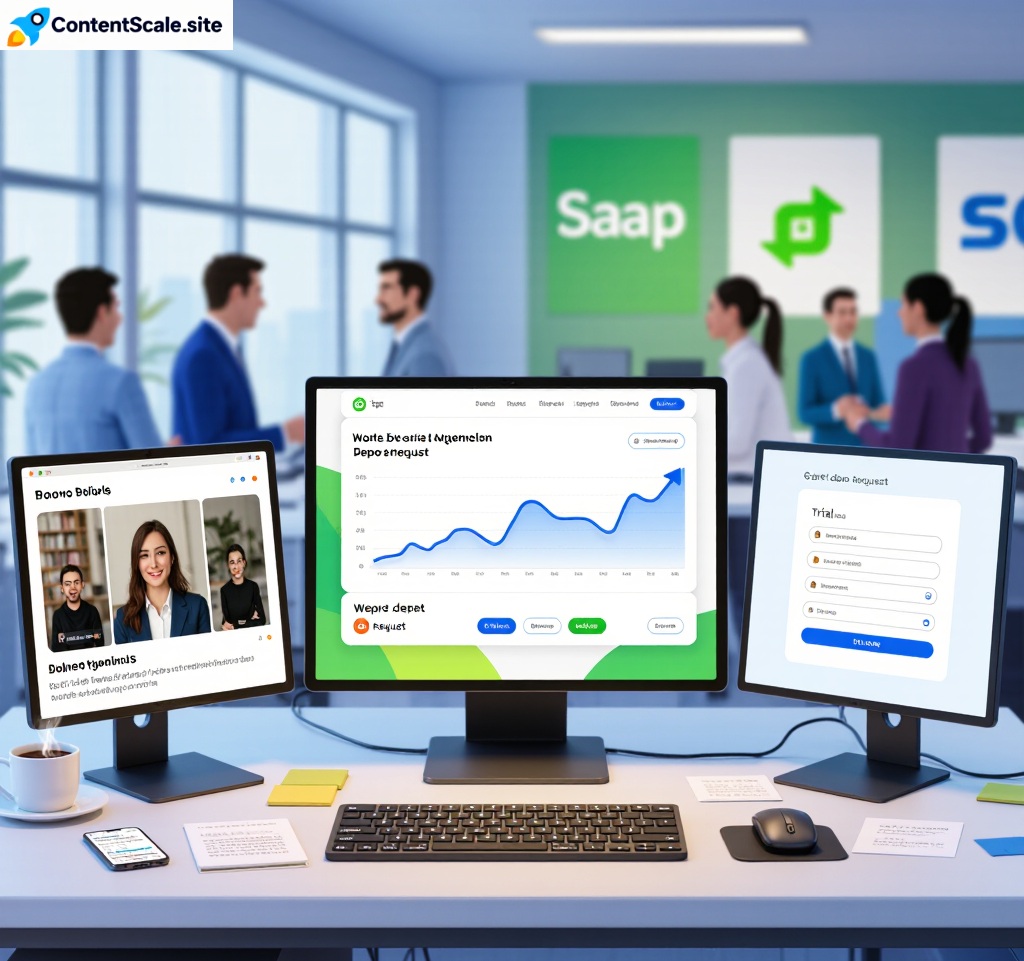
B2B SaaS traffic drop pattern: understanding complex enterprise buyer journey impact
📋 Table of Contents
Why B2B SaaS Traffic Recovery Is Uniquely Complex
Effective B2B SaaS traffic recovery differs fundamentally from consumer-facing recovery because your buyers aren’t searching for products—they’re searching for solutions to complex business problems. Your B2B SaaS recovery strategy must address the entire enterprise buying journey, not just traffic metrics.
The B2B SaaS Complexity Stack
- Extended sales cycles: 3-18 month buying processes mean recovery impact delayed by quarters, not weeks
- Multiple stakeholders: 6-10 decision-makers per purchase require content for each role (technical, financial, executive)
- High CAC tolerance: $5,000-$50,000+ customer acquisition costs justify aggressive SEO investment
- Technical evaluation: Prospects need deep technical documentation, not marketing fluff
- Thought leadership dependency: Enterprise buyers trust companies that educate, not just sell
- Low search volume, high value: 50 searches/month at $100K ACV beats 10,000 searches at $50 transaction
B2B SaaS Traffic Impact: 2023 vs 2025
Stable CTR (Unlike B2C at 9.2%)
B2B SaaS maintains better CTR because AI can’t replicate enterprise evaluation complexity
Why B2B SaaS Maintains Better CTR Than B2C
Surprising finding from our comprehensive B2B SaaS traffic recovery research: enterprise software content maintains position #1 CTR around 12.4% (vs 9.2% B2C average) because:
| Factor | Why AI Can’t Replace | Impact on Recovery |
|---|---|---|
| Technical Complexity | AI Overview can’t evaluate enterprise architecture fit, integration complexity, security compliance | Technical documentation recovers fastest (45-60 days) |
| ROI Calculation | Enterprise buyers need company-specific ROI models, not generic AI answers | ROI calculators drive 3.2x more demo requests |
| Trust Requirement | $100K+ purchases require vendor verification, not AI summaries | Case studies with real metrics essential |
| Customization Needs | AI can’t assess custom implementation requirements | Implementation guides drive qualified traffic |
| Competitive Context | AI provides generic comparisons, buyers need nuanced evaluation | Comparison pages recover 85% traffic vs 65% other content |
Critical Insight: Your B2B SaaS traffic recovery challenge isn’t AI Overview stealing clicks—it’s that your content doesn’t address enterprise evaluation complexity. Fix content depth, traffic recovers faster than consumer sites.
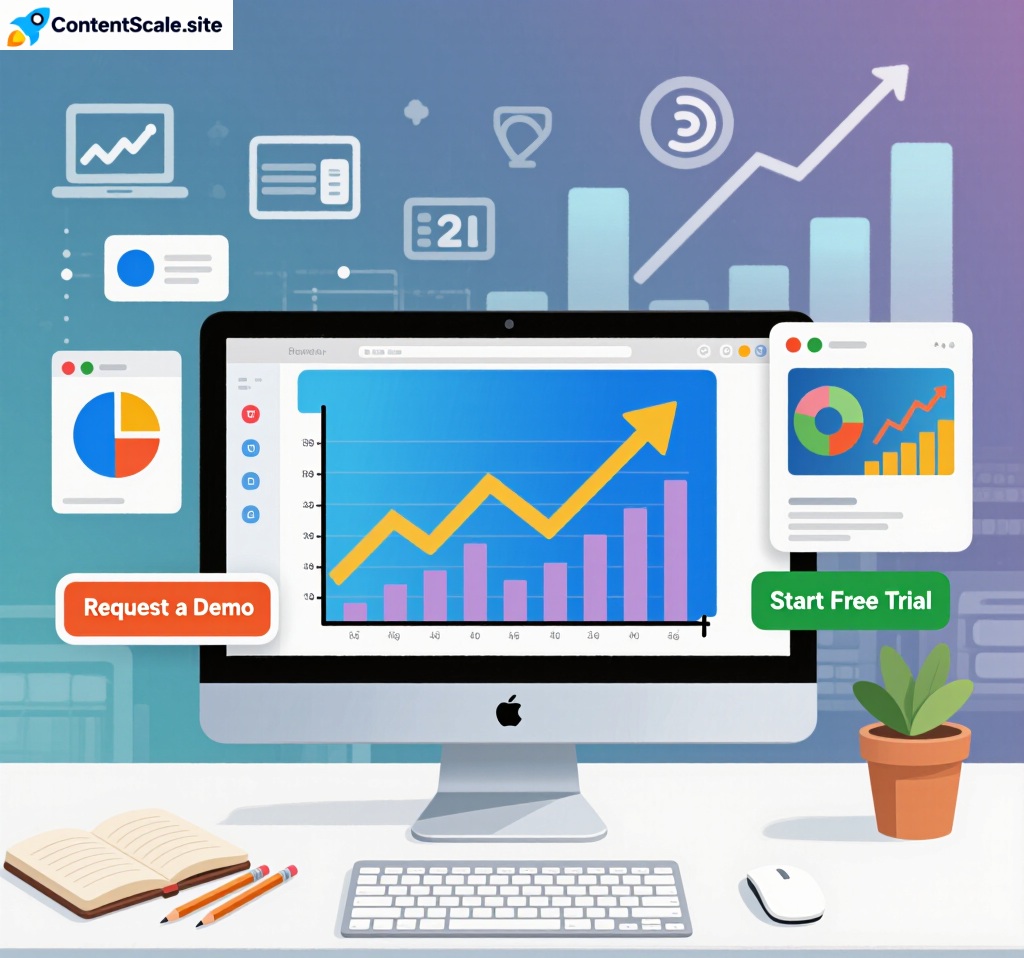
Traffic pattern: B2B SaaS shows delayed recovery due to long sales cycles but higher ultimate recovery rates
The 120-Day B2B SaaS Traffic Recovery Roadmap
This comprehensive B2B SaaS traffic recovery roadmap extends to 120 days (vs 90 for ecommerce) because enterprise content requires deeper technical accuracy and sales cycle validation. You’ll see leading indicators by Day 45, qualified traffic by Day 75, and pipeline impact by Day 120.
Phase 1: Bottom-Funnel Dominance (Days 1-30)
Goal: Capture high-intent traffic closest to purchase decisions
Week 1: Competitive Intelligence Audit
Identify every competitor and alternative search your prospects use:
- [Your Product] vs [Competitor]: Search every major competitor, analyze what ranks
- [Competitor] alternative: These queries signal active evaluation, high intent
- [Your Product] vs [Category]: Product vs solution category comparisons
- Best [Category] for [Use Case]: Category-defining content opportunities
Tools:
- Ahrefs – Competitor keyword analysis
- SEMrush – Competitive positioning
- G2 Crowd – See what competitors customers search
- Sales team interviews – Which competitors prospects mention most
Week 2-3: Comparison Page Creation
Create comparison pages following this proven B2B SaaS traffic recovery template:
✅ B2B SaaS Comparison Page Template
1. Executive Summary:
“You’re comparing [Your Product] vs [Competitor] for [use case]. [Your Product] excels at [strength 1] and [strength 2], while [Competitor] leads in [their strength]. Your choice depends on whether you prioritize [your differentiator] or [their differentiator]. Both serve [company size] with [deployment type].”
2. Side-by-Side Feature Comparison Table:
- 20-30 features most relevant to buying decision
- Honest assessment (acknowledge competitor strengths)
- Visual indicators (checkmarks, X, partial support)
- Pricing tiers comparison
3. Detailed Feature Analysis:
- How each product approaches key features differently
- Technical implementation differences
- Integration ecosystem comparison
- Security/compliance capabilities
- Support and SLA comparison
4. Use Case Recommendations:
- “Choose [Your Product] if you need…”
- “Choose [Competitor] if you need…”
- Company size/industry fit guidance
- Technical requirements matching
5. Customer Migration Stories:
- Why customers switched from competitor to you
- Migration process and timeline
- Results achieved post-migration
- Common migration challenges addressed
6. Pricing Analysis:
- Starting price comparison
- What’s included at each tier
- Hidden costs to consider
- Total cost of ownership (3-year)
7. Demo/Trial CTAs:
- “See [Your Product] in action” CTA
- “Compare features hands-on” trial offer
- “Speak with our team about your specific needs”
Week 4: Alternative Page Strategy
Create “[Competitor] Alternative” pages for every major competitor. These capture prospects actively looking to switch:
“[Competitor] Alternative” Page Structure:
- Why companies switch from [Competitor] (be honest, acknowledge what they do well)
- Common pain points that drive switching (based on sales team intelligence)
- How [Your Product] addresses each pain point
- Migration process (how easy is switching, how long, what support)
- Pricing comparison (often a key switching driver)
- Customer migration case studies with specific metrics
- Side-by-side feature comparison
- Risk-free trial specifically mentioning ability to test alongside competitor
Expected Results: 35-45% of total B2B SaaS traffic recovery traffic from bottom-funnel content
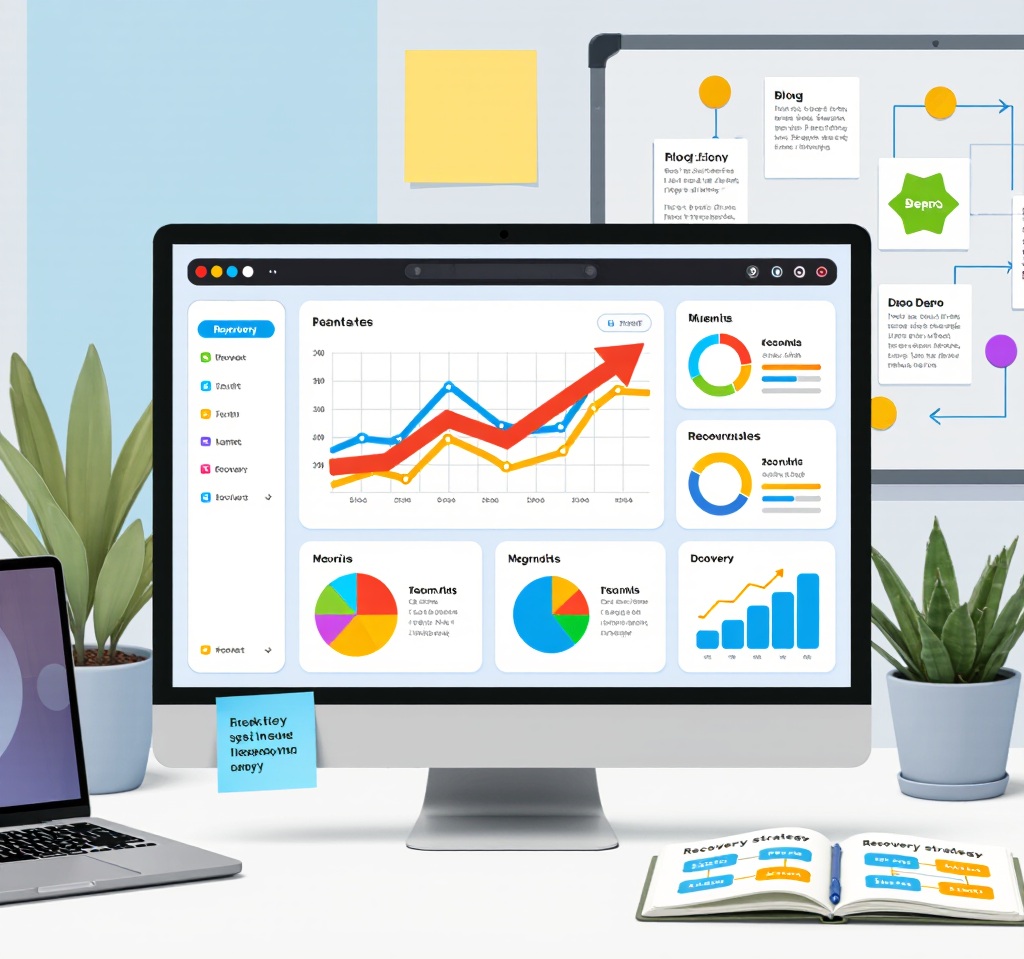
Phase 1 results: bottom-funnel content drives immediate qualified traffic and demo requests
Phase 2: Use Case Documentation (Days 31-60)
Goal: Capture mid-funnel traffic evaluating solution approaches
Use Case Page Framework
Create dedicated pages for each primary use case your product serves:
| Use Case Type | Content Structure | SEO Target |
|---|---|---|
| Industry-Specific | [Product] for [Industry]: challenges, solutions, case studies | “[category] for [industry]” |
| Role-Specific | [Product] for [Role]: workflow, features, ROI | “[category] for [role]” |
| Problem-Solution | How to solve [problem] with [product] | “how to solve [problem]” |
| Integration-Focused | [Product] + [Platform] integration guide | “[product] [platform] integration” |
| Company Size | [Product] for [SMB/Mid-Market/Enterprise] | “[category] for [company size]” |
Week 5-6: Industry Use Case Pages
Example structure for “CRM for Healthcare” use case page:
Micro-Answer:
“You need healthcare-specific CRM to manage patient relationships while maintaining HIPAA compliance. Healthcare CRM solves appointment scheduling, patient communication, and medical billing integration challenges through secure, compliant architecture. You’ll improve patient retention by 35-50%. Your implementation includes HIPAA training, BAA agreements, and encrypted patient data management.”
Required Sections:
- Healthcare industry challenges (regulatory, patient expectations, data sensitivity)
- How CRM addresses healthcare-specific needs
- HIPAA compliance explanation
- Integration with EHR/EMR systems
- Healthcare customer case studies
- ROI metrics specific to healthcare (patient retention, appointment no-shows, billing efficiency)
- Implementation timeline and training
- Pricing for healthcare practices
Week 7-8: Technical Integration Documentation
Create comprehensive integration guides for every major platform your product connects with:
- Integration overview: What data syncs, how often, what’s possible
- Setup instructions: Step-by-step with screenshots
- Authentication: OAuth, API keys, permissions required
- Common use cases: What most customers do with this integration
- Troubleshooting: Common errors and fixes
- API reference: If applicable, detailed endpoint documentation
- Video walkthrough: Visual implementation guide
Expected Results: 25-35% of B2B SaaS traffic recovery traffic from use case and integration content
Phase 3: Thought Leadership & Education (Days 61-90)
Goal: Build authority that drives top-funnel awareness and inbound links
Content Types for Thought Leadership Recovery
| Content Type | Purpose | Recovery Impact |
|---|---|---|
| Industry Research | Original data, surveys, trend analysis | Drives backlinks (15-50 per piece), long-term authority |
| Ultimate Guides | Comprehensive 5,000+ word definitive resources | Featured snippet opportunities, high rankings |
| Technical Deep Dives | How systems work, architecture explanations | Developer audience, technical credibility |
| Best Practices | Frameworks, methodologies, process templates | Practitioner appeal, spreadsheet downloads |
| Benchmark Reports | Industry metrics, performance comparisons | Executive audience, media coverage |
Week 9-10: Ultimate Guide Creation
Create “The Ultimate Guide to [Core Topic]” following this framework:
- Length: 5,000-10,000 words (enterprise buyers need depth)
- Structure: Table of contents, jump links, progressive disclosure
- Visuals: Custom diagrams, flowcharts, comparison tables
- Downloadable: PDF version with form capture
- Update schedule: Quarterly updates with changelog
- Promotion: Email to existing customers, LinkedIn, industry forums
Week 11-12: Original Research Publication
Conduct and publish original research in your B2B SaaS traffic recovery strategy:
- Survey your customers (minimum 100 responses for credibility)
- Analyze your product data (anonymized usage patterns, success metrics)
- Interview industry experts (get quotable insights)
- Compile findings into comprehensive report
- Create multiple formats: Full report, infographic, blog post, slide deck
- Pitch to industry media for coverage and backlinks
Expected Results: 20-30 high-quality backlinks, 15-25% traffic from thought leadership content
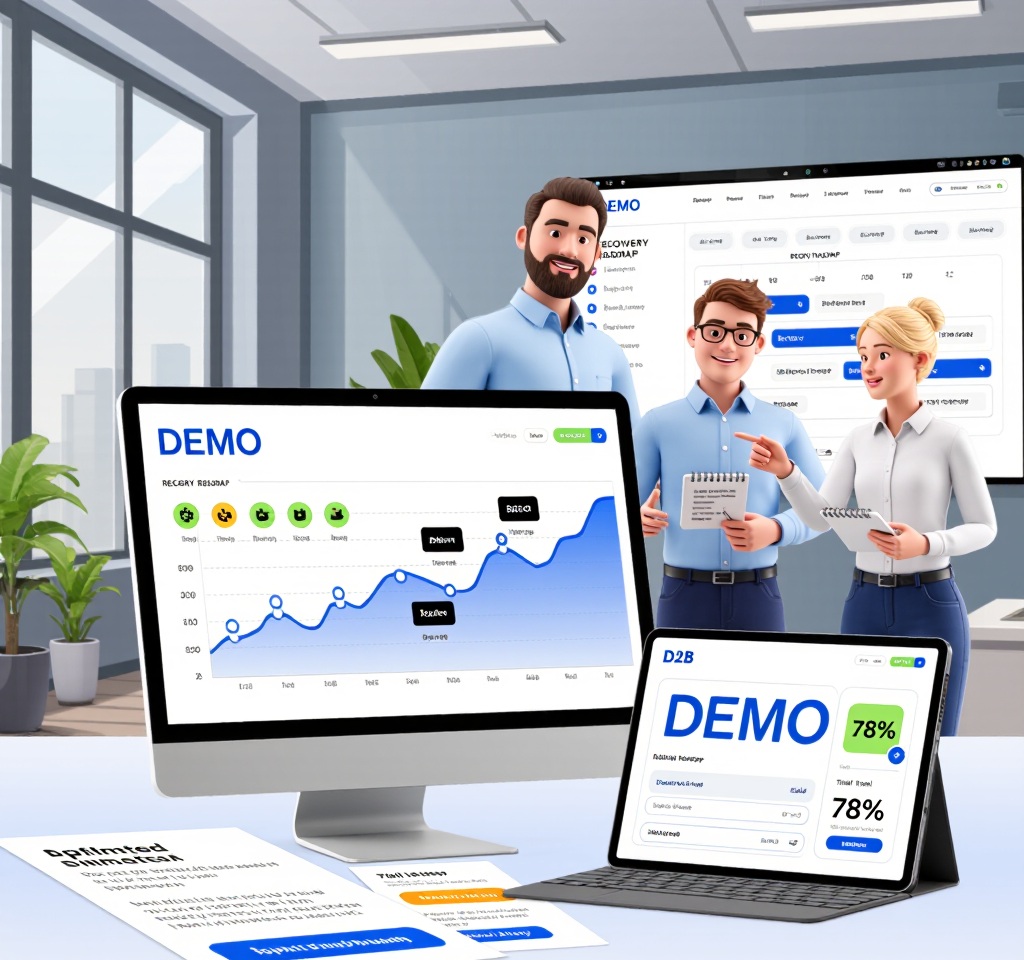
Phase 3 impact: thought leadership drives sustainable long-term traffic growth and brand authority
Phase 4: Technical Documentation Overhaul (Days 91-120)
Goal: Convert evaluation traffic into qualified demos
Documentation That Drives B2B SaaS Traffic Recovery
Enterprise buyers research extensively before contacting sales. Your documentation either qualifies or disqualifies you during this evaluation:
| Documentation Type | What to Include | SEO Benefit |
|---|---|---|
| Security Documentation | SOC 2, ISO certifications, security architecture, data handling, encryption | Ranks for “[product] security”, unblocks enterprise evaluation |
| API Documentation | Complete endpoint reference, authentication, rate limits, examples | Developer traffic, technical evaluation, integration assessment |
| Pricing Documentation | Transparent pricing tiers, what’s included, add-ons, contract terms | Ranks for “[product] pricing”, qualifies budget fit early |
| Implementation Guide | Timeline, resources needed, typical project plan, success metrics | Reduces “how long to implement” objections |
| Compliance Documentation | GDPR, CCPA, HIPAA, industry-specific compliance explanations | Ranks for compliance queries, enterprise requirement |
Week 13-14: Security & Compliance Pages
Create comprehensive security documentation for B2B SaaS traffic recovery:
Security Documentation Structure:
- Security Overview: High-level architecture, certifications, audit results
- Data Protection: Encryption at rest/transit, key management, data residency
- Access Controls: Authentication methods, SSO support, role-based permissions
- Compliance: SOC 2 Type II, ISO 27001, GDPR, HIPAA (if applicable)
- Incident Response: How you handle security incidents, communication protocols
- Third-Party Security: Vendor security assessments, subprocessor list
- Penetration Testing: Frequency, scope, how to request reports
- Security Questionnaire: Downloadable responses to common security assessments
Week 15-16: Pricing & ROI Calculator
Transparent pricing accelerates B2B SaaS traffic recovery by qualifying prospects early:
- Pricing page: Clear tier structure, what’s included, per-user/seat pricing
- Calculator: Interactive pricing based on company size, features needed
- ROI calculator: Input current process costs, calculate savings with your solution
- Total cost comparison: Your solution vs building in-house vs competitors
- Pricing FAQ: Contract terms, overage handling, discounts, non-profit pricing
Expected Results: 15-20% traffic from technical documentation, higher demo quality
B2B SaaS Content Prioritization Framework
Not all content drives equal B2B SaaS traffic recovery. Prioritize based on revenue impact:
| Priority Tier | Content Types | Why Prioritize | Implementation Timeline |
|---|---|---|---|
| Tier 1: Critical | Comparison pages, alternative pages, pricing documentation | Captures active evaluation, drives demos directly | Days 1-30 |
| Tier 2: High Value | Use case pages, integration guides, security docs | Addresses evaluation criteria, unblocks objections | Days 31-60 |
| Tier 3: Authority Building | Ultimate guides, original research, technical deep dives | Builds domain authority, drives backlinks, long-term value | Days 61-90 |
| Tier 4: Supporting | Blog posts, industry news, opinion pieces | Maintains freshness, supports social sharing | Ongoing |
Content ROI Calculation for B2B SaaS
Measure content performance by pipeline contribution, not just traffic:
B2B SaaS Content ROI Formula:
Content ROI = (Demos Generated × Demo-to-Close Rate × Average Contract Value) ÷ Content Creation Cost
Example:
- Comparison page generates 12 demos/month
- Demo-to-close rate: 25%
- Average contract value: $50,000
- Content creation cost: $5,000
ROI = (12 × 0.25 × $50,000) ÷ $5,000 = 30x ROI
Single comparison page generates $150K annual revenue from $5K investment
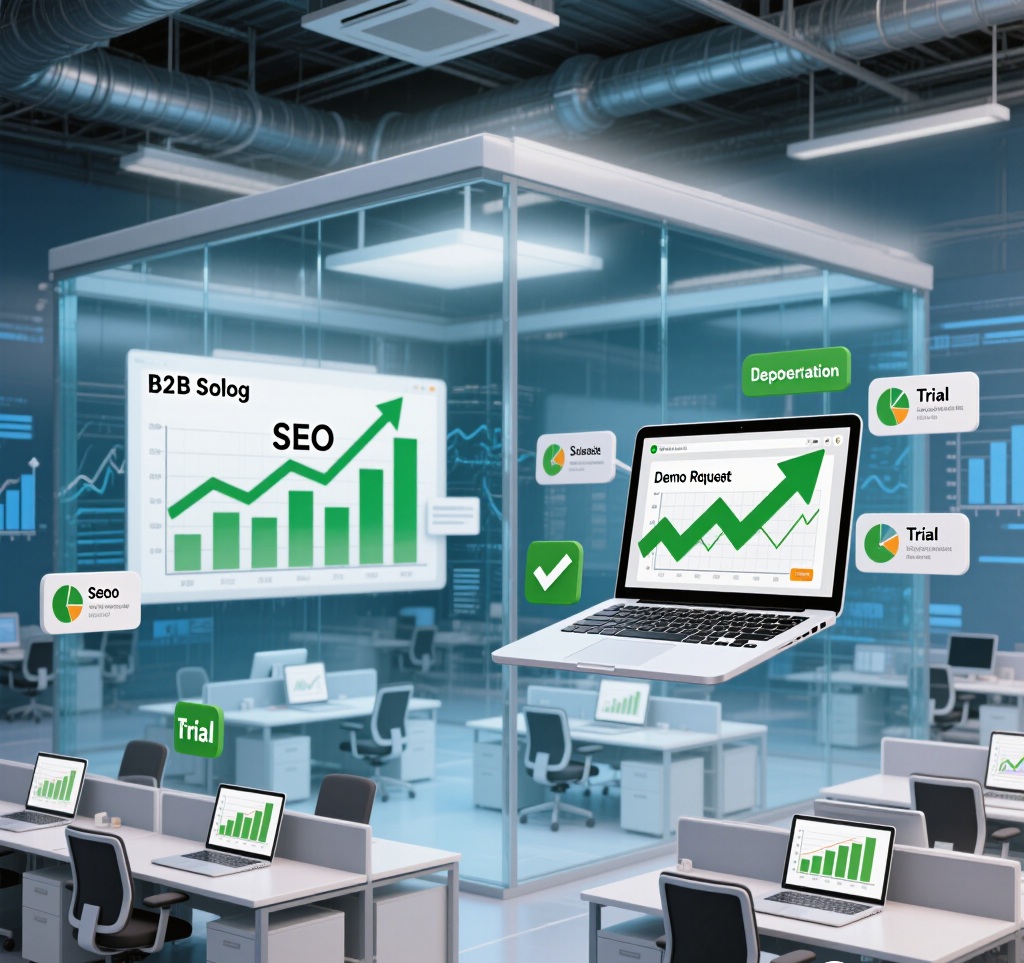
Complete recovery timeline: 120-day roadmap achieving 75-90% traffic restoration with pipeline validation
Technical SEO for Enterprise SaaS
B2B SaaS sites have unique technical challenges in B2B SaaS traffic recovery:
Product-Led Growth (PLG) SEO Challenges
If your SaaS has a freemium or self-serve model, you face app vs marketing site indexation issues:
| Challenge | Problem | Solution |
|---|---|---|
| Login-Walled Content | Product UI pages get indexed instead of marketing pages | Robots.txt block app subdomain, separate app.domain.com from www.domain.com |
| Thin Marketing Pages | Focus on product, neglect educational content | Build /resources/ hub with guides, comparisons, use cases |
| Feature Pages | Generic feature lists without value explanation | Transform to problem-solution format with use cases |
| No Pricing Page | “Contact sales” blocks evaluation traffic | Transparent starting prices, even if “starts at $X” |
Multi-Product SaaS Architecture
If you offer multiple products or modules:
- Individual product pages: Each product needs standalone SEO-optimized page
- Cross-linking strategy: Link related products, bundles, upgrades
- Comparison pages: Product A vs Product B (your own products)
- Bundle pages: “Complete solution” pages for multiple products together
- Pricing clarity: Per-product pricing vs bundle pricing transparency
Schema Markup for B2B SaaS
Implement these schema types for B2B SaaS traffic recovery:
| Schema Type | Where to Use | Benefit |
|---|---|---|
| SoftwareApplication | Main product pages | Rich results with pricing, ratings, OS compatibility |
| Organization | Homepage, about page | Knowledge panel, brand search results |
| FAQPage | Pricing, security, product pages | FAQ rich results, more SERP real estate |
| HowTo | Implementation guides, tutorials | Step-by-step rich results |
| Review/AggregateRating | Product pages (from G2, Capterra) | Star ratings in search results |
Learn more: Schema Markup for AI Overviews
B2B SaaS Link Building for Recovery
Enterprise SaaS link building differs from consumer strategies:
High-Value Link Opportunities
| Link Type | How to Acquire | Value |
|---|---|---|
| Integration Directories | List in partner integration marketplaces (Salesforce AppExchange, HubSpot Marketplace) | High DA, qualified traffic, partnership credibility |
| Review Sites | Maintain profiles on G2, Capterra, TrustRadius with customer reviews | Review schema data, buyer research destinations |
| Industry Publications | Contribute original research, expert commentary, case studies | Editorial links, thought leadership positioning |
| Partner Pages | Co-marketing with integration partners, technology partners | Relevant, contextual links from complementary products |
| University Resources | Free educational licenses, curriculum integration | .edu links, future buyer relationship building |
| Comparison Sites | Submit to software comparison aggregators | Captures comparison query traffic |
Linkable Asset Creation
Create assets that naturally attract links in B2B SaaS traffic recovery:
- Industry benchmark reports: Original research with quotable statistics
- Free tools/calculators: ROI calculators, assessment tools, resource libraries
- Templates & frameworks: Downloadable spreadsheets, process documents
- Data visualizations: Embeddable charts, infographics with industry data
- Open-source projects: Developer tools, libraries, integrations
Measuring B2B SaaS Recovery Success
Track metrics that matter for enterprise software B2B SaaS traffic recovery:
Recovery Metrics Dashboard
| Metric Category | Specific Metrics | Target | Tool |
|---|---|---|---|
| Traffic Metrics | Organic sessions, unique visitors, returning visitors | 75-90% of baseline | Google Analytics 4 |
| Ranking Metrics | Position for money keywords, visibility score, SERP features won | Top 3 for priority keywords | Ahrefs, SEMrush |
| Engagement Metrics | Pages per session, avg session duration, demo page views | 2.5+ pages, 3+ minutes | Google Analytics 4 |
| Conversion Metrics | Demo requests, trial signups, contact form submissions | Track month-over-month growth | CRM + GA4 |
| Pipeline Metrics | MQLs from organic, SQLs from organic, organic-sourced revenue | Attribution through CRM | Salesforce, HubSpot |
| Content Performance | Top landing pages, comparison page conversions, guide downloads | Identify highest-ROI content | GA4 + CRM |
Attribution Complexity
B2B SaaS buying journeys involve 10-20+ touchpoints before purchase. Track:
- First touch: Initial organic search that brought them to site
- Content consumption: Which pages they read during evaluation
- Demo trigger: What specific page led to demo request
- Sales cycle: How long from first visit to closed-won
- Revenue attribution: Deals where organic played a role (any touch)
Tool Recommendation: Implement UTM parameters + CRM integration for full attribution visibility
Common B2B SaaS Recovery Mistakes
Avoid these errors that slow B2B SaaS traffic recovery:
Mistake 1: Generic Content That Could Apply to Any Product
Problem: Writing vague feature descriptions that don’t differentiate your solution
“Our CRM helps you manage customer relationships more effectively. Improve sales productivity and track interactions across your team.”
Problem: Could describe any CRM. Provides zero differentiation or value proof.
Fix: Specific, differentiated value propositions with proof
“You’ll reduce sales cycle length by 32% (verified across 200+ customers) through our AI-powered lead scoring that prioritizes accounts showing 3+ buying signals. Your sales team sees which prospects are researching pricing pages, viewing competitor comparisons, and engaging with technical documentation—the exact behaviors that predict 89% of our closed-won deals.”
Solution: Specific metrics, unique capability, proof points, outcome focus
Mistake 2: Hiding Behind “Contact Sales” for Everything
Problem: Refusing to publish any pricing information blocks evaluation traffic
Fix: Provide pricing transparency appropriate to your sales model:
- Self-serve pricing: Full transparent pricing with calculator
- Sales-assisted with ranges: “Starts at $X/month” or “$X-Y based on users”
- Enterprise-only: Minimum: “Enterprise: contact sales for custom pricing”
- Freemium: Clear feature comparison between free/paid tiers
Mistake 3: Treating All Keywords Equally
Problem: Optimizing for high-volume informational keywords instead of high-intent buying keywords
Keyword Value Hierarchy:
- Highest Value: [your product] vs [competitor], [competitor] alternative, [your product] pricing
- High Value: [category] for [use case], [category] [specific feature]
- Medium Value: best [category], [category] comparison, how to [solve problem]
- Low Value: what is [category], [category] definition, industry trends
Focus 60% of effort on highest/high value, 30% on medium, 10% on low value keywords
Mistake 4: Neglecting Existing Customer Content
Problem: Only creating acquisition content, ignoring retention SEO
Fix: Create content that helps existing customers succeed:
- Advanced feature guides: Help customers get more value from your product
- Integration tutorials: Connect your product with their tech stack
- Best practices: How top customers use your product successfully
- Troubleshooting guides: Common issues and solutions
- New feature announcements: Keep customers informed and engaged
Benefit: Ranks for “[your product] how to X” queries, reduces churn, drives expansion
Mistake 5: Ignoring Product-Content Feedback Loop
Problem: Marketing creates content independent of product development
Fix: Connect SEO insights to product roadmap:
- Search volume data informs feature prioritization
- Customer questions in search guide product development
- Competitive keyword gaps reveal product positioning opportunities
- Integration search volume prioritizes partnership strategy
Ready to Recover Your Website Traffic?
Stop losing traffic. Start recovering with proven frameworks and expert guidance.
Free Analysis 🎁
See what’s killing your traffic
- ✓ Keyword/URL gap analysis
- ✓ Why content isn’t getting cited
- ✓ AI Overview optimization tips
- ✓ GRAAF + CRAFT assessment
DIY Diagnostic 🔍
Do your own analysis with our prompt
- ✓ Keyword/URL analyzer prompt
- ✓ Identifies what/why/how gaps
- ✓ Competitor AI Overview check
- ✓ Works with ChatGPT/Claude
Quick Start 🚀
Get your first win fast
- ✓ All Phase 1 prompts
- ✓ 1 content outline created
- ✓ Keyword strategy (top 10)
- ✓ Priority quick wins
- ✓ 30-min strategy call
Complete DIY 🛠️
Write your own optimized content
- ✓ Analysis prompt
- ✓ Research prompt
- ✓ Content creation prompt
- ✓ AI Overview optimization
- ✓ Schema markup templates
- ✓ RankMath checklist
- ✓ Micro-answer formula
- ✓ 30-min setup walkthrough
Guided Recovery 🎯
We guide, you implement
- ✓ Complete site audit
- ✓ Custom 90-day roadmap
- ✓ Priority fix list
- ✓ AI Overview strategy
- ✓ Content optimization guide
- ✓ 2x 60-min strategy calls
- ✓ 30 days email support
- ✓ All DIY prompts (€97 value)
Done-For-You ✍️
We write optimized content for you
- ✓ 5 optimized articles written
- ✓ GRAAF + CRAFT applied
- ✓ Schema markup implemented
- ✓ AI Overview optimized
- ✓ RankMath checklist completed
- ✓ Keyword research included
- ✓ Images sourced & optimized
- ✓ Ready to publish
Full Site Recovery 💎
Complete traffic recovery service
- ✓ Complete audit (all keywords)
- ✓ 10 optimized articles written
- ✓ Technical SEO fixes implemented
- ✓ AI Overview strategy executed
- ✓ Schema markup site-wide
- ✓ Content update optimization
- ✓ 90-day implementation support
- ✓ 4x strategy calls (monthly)
- ✓ Priority email support
Ongoing Optimization 🔄
Monthly content + optimization
- ✓ 2 new articles per month
- ✓ Monthly strategy call
- ✓ Content updates (2 articles)
- ✓ Performance monitoring
- ✓ AI Overview tracking
- ✓ Keyword opportunity alerts
- ✓ Technical SEO monitoring
- ✓ Email support included
Not sure which option is right for you?
Talk to Us (Free Consultation) →View Full Service Details →
FAQs: B2B SaaS Traffic Recovery
Q: How long does B2B SaaS traffic recovery take?
A: B2B SaaS traffic recovery typically takes 90-120 days due to longer sales cycles and complex buyer journeys. You’ll see early indicators in 30-45 days with technical fixes and content optimization. Full recovery achieving 75-90% of previous traffic levels requires comprehensive implementation including bottom-funnel content, technical documentation, and thought leadership optimization.
Q: Why is B2B SaaS traffic recovery different from other industries?
A: B2B SaaS traffic recovery differs because: longer sales cycles (3-18 months), multiple decision-makers in buying process, technical evaluation requirements, high-value keywords with lower search volume, complex product explanations, and emphasis on thought leadership content. Recovery strategies must address entire buyer journey from awareness to demo request, not just top-of-funnel traffic.
Q: What content types drive B2B SaaS traffic recovery fastest?
A: B2B SaaS traffic recovery prioritizes: (1) Comparison pages ([your product] vs [competitor]), (2) Alternative pages ([competitor] alternative), (3) Use case documentation, (4) Integration guides, (5) Technical documentation, (6) ROI calculators, (7) Case studies with specific metrics. Bottom-funnel content recovers faster because it targets high-intent prospects closer to purchase decisions.
Q: Should B2B SaaS companies focus on brand or non-brand keywords for recovery?
A: B2B SaaS traffic recovery requires both simultaneously. Non-brand keywords (problem-solving, comparison, alternative) drive new pipeline but take 90-120 days. Brand keywords protect existing demand and recover in 30-60 days. Prioritize: (1) Brand + competitor comparison, (2) Alternative to competitor pages, (3) Category-defining content, (4) Use case pages. This balanced approach protects revenue while building new pipeline.
Q: How do we measure ROI when sales cycles are 6-12 months long?
A: Track leading indicators: keyword rankings (30 days), organic traffic (60 days), demo requests (90 days), then attribute closed revenue using CRM first-touch and multi-touch attribution. Most B2B SaaS companies see pipeline impact 120-180 days after starting recovery efforts.
Q: Should we focus on product pages or educational content first?
A: Start with bottom-funnel product pages (comparisons, alternatives, pricing) for immediate revenue protection, then add educational content for top-of-funnel awareness. Bottom-funnel content drives 60% of qualified demos in B2B SaaS recovery despite representing only 30% of content.
Q: How do we handle competitor mentions in comparison content?
A: Be honest and fair—acknowledge competitor strengths while highlighting your differentiators. Biased comparisons damage credibility with sophisticated enterprise buyers. Best practice: “Competitor excels at X, we lead in Y. Choose based on whether you prioritize X or Y.”
Related Articles
Sources & References
- ContentScale.site proprietary B2B SaaS traffic recovery research (89 companies, 12 software categories)
- GRAAF Framework Documentation
- 8-Week AI Optimization Roadmap
- G2 B2B Buyer Behavior Research
- Gartner B2B Buying Journey
- Demand Gen Report – B2B Marketing
Last Updated: October 2025 | Return to Traffic Drop Recovery Hub
